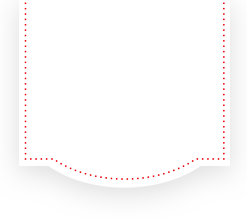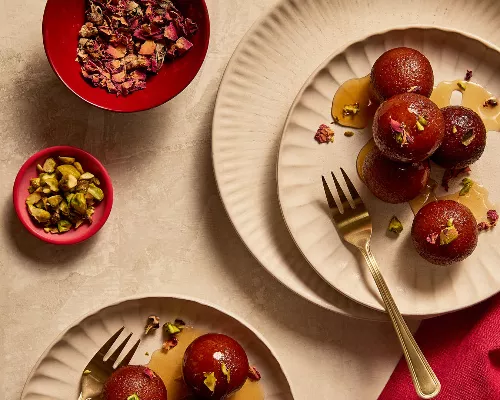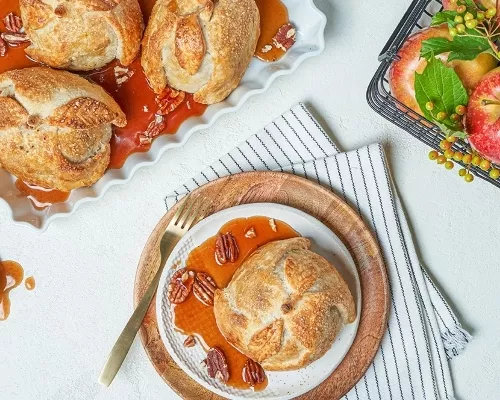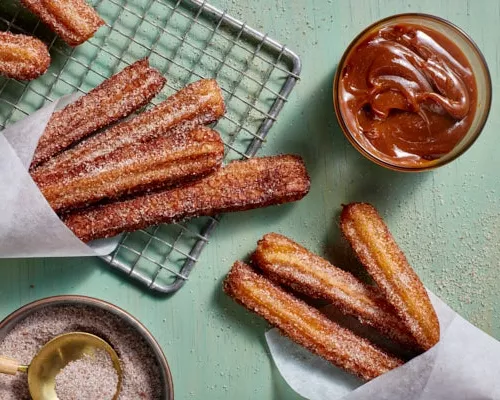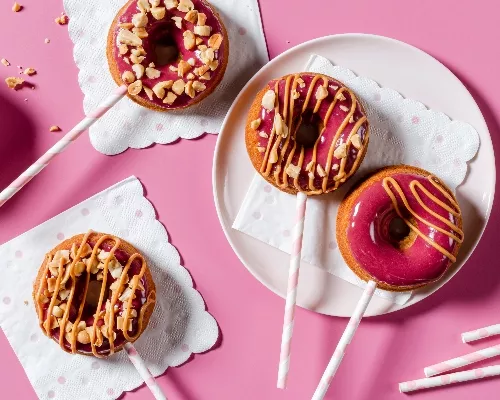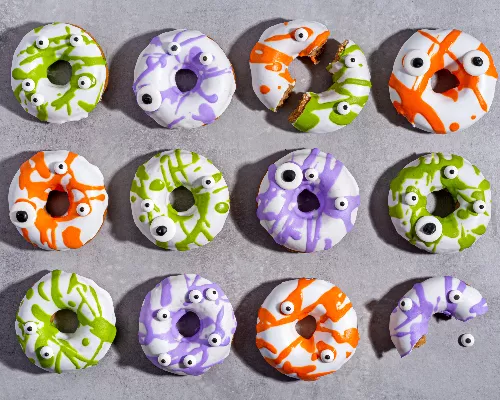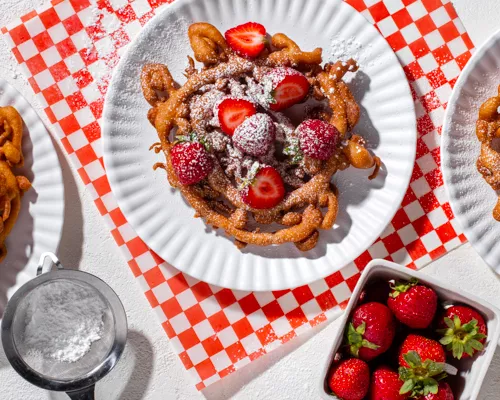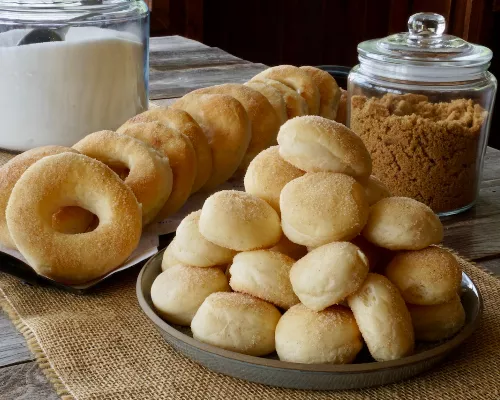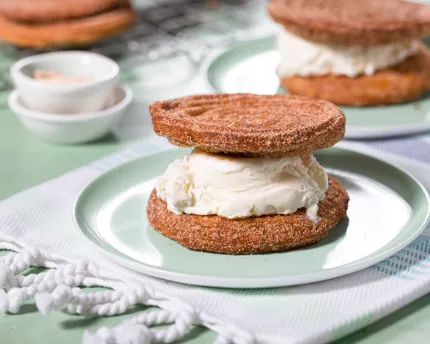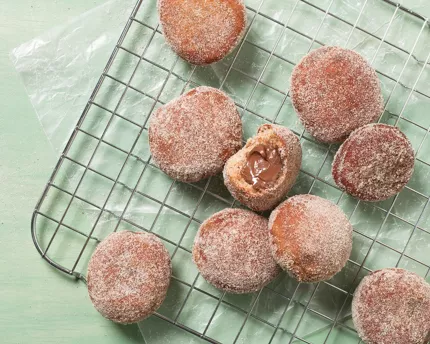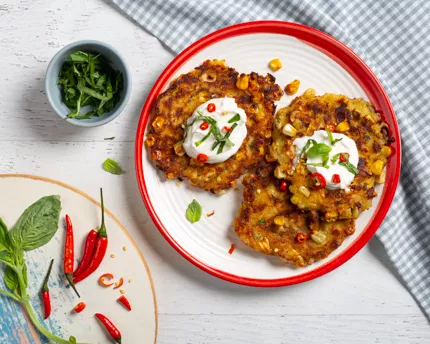Step 1
In a large, heavy-bottomed saucepan, combine milk, the Redpath® Granulated Sugar, vanilla extract (or half a vanilla bean that has been split in half and seeds scraped, pod included), and salt. Place over medium heat, stirring occasionally to dissolve the sugar. Bring mixture to a simmer.
Step 2
In a small bowl, stir together the water and baking soda until dissolved.
Step 3
Remove the simmering milk mixture from the heat and add the baking soda solution to the pot; mixture will bubble up and become frothy. Keep stirring to prevent the mixture from bubbling over. When the bubbles subside, return the pot to the heat.
Step 4
Cook on medium heat until mixture returns to a simmer. Reduce heat to medium-low and continue cooking, stirring frequently, until mixture thickens and darkens in colour; 45 minutes to 1 hour. The longer the caramel is cooked, the more intense the caramel flavour will be. Note that the sauce will continue to thicken as it cools.
Step 5
Remove from heat once the desired consistency and a deep golden brown colour are reached (the sauce is ready when it leaves a clear path on the bottom of the pot and is similar in consistency to maple syrup or thicker).
Step 6
Carefully remove the vanilla pod if used. Transfer desired amount of sauce to a small dish for dipping and cover loosely with plastic wrap to keep warm. Transfer the remaining sauce into a heat-proof jar or container to cool completely. Cover and refrigerate for up to 3 weeks. Warm up desired amount before using as a dipping sauce.
Step 1
In a medium-sized rimmed plate or small baking dish, whisk together the Redpath® Granulated Sugar and cinnamon until evenly combined. Set aside.
Step 1
In a high-sided, heavy-bottomed saucepan, cast iron pan, or Dutch oven, fill with 1½ to 3 inches of canola oil. Place pan over medium heat and slowly bring the temperature to 360°F to 365°F (182°C to 185°C).
Step 2
In a heavy-bottomed pot, combine the water, cubed butter, the Redpath® Granulated Sugar, and salt. Place over medium-high heat and bring to a boil, stirring to dissolve the butter and sugar. Carefully add all of the flour into the boiling water and stir in. Reduce heat to medium-low. Vigorously stir the mixture until it forms a smooth ball; 1 minute.
Step 3
Remove from heat. Transfer dough to the bowl of a stand mixer fitted with the paddle attachment or a large bowl using a hand mixer. Let cool for 5 minutes; this prevents the eggs from scrambling upon contact.
Step 4
In a small bowl, whisk together the eggs and vanilla extract.
Step 5
Begin beating the slightly cooled dough. Add half of the egg mixture to the dough while beating. Mix until it comes together. Repeat process with the remaining egg mixture until batter is homogeneous.
Step 6
Transfer the batter to a large piping bag fitted with a closed star tip (see Chef’s Tips).
This method will produce churros that tend to curve and are more wavy than straight.
Step 1
Holding the tip close to the hot oil, pipe a line of batter about 6 inches long directly into the oil. With a pair of scissors dipped in oil, snip off the batter. Pipe 2 or 3 more lines of batter into the oil.
Step 2
Fry about 2 to 3 minutes per side until golden brown in colour. Use tongs to help straighten the dough, if necessary, and keep them from sticking to each other.
Step 1
Pipe lines of batter, about 6 inches long, onto a baking sheet lined with parchment paper. Space each line of batter about an inch apart. Place into the freezer to harden; at least 15 minutes.
Step 2
With scissors, cut the parchment paper around each batch (3 or 4 churros). Carefully slide the parchment paper with the batch of churros into the hot oil.
Step 3
After a few seconds, use tongs to wiggle the parchment paper to release the churros from the paper. Remove parchment paper with tongs; discard. Fry until golden brown in colour; 5 to 7 minutes.
Step 4
Alternatively, freeze for several minutes longer and gently peel churros off the parchment paper and carefully lower them into the oil. Fry 3 or 4 churros at a time.
Step 1
Pipe lines of batter about 6 inches long onto a baking sheet lined with parchment paper. Space piped churros about an inch apart. Place into the fridge to chill; at least 20 minutes.
Step 2
With scissors, cut the parchment paper around each batch (3 or 4 churros). Carefully slide the parchment paper with the batch of churros into the hot oil.
Step 3
After a few seconds, use tongs to wiggle the parchment paper to release the churros from the paper. Remove parchment paper with tongs; discard. Fry until golden brown in colour; 5 to 6 minutes.
Step 1
After removing the fried churros from the oil, place onto a baking sheet lined with paper towels to remove excess oil.
Step 2
After about a minute, place the still-warm churros into the cinnamon-sugar mixture. Shake dish back and forth to coat the churros. Remove and place onto a serving dish.
Serve churros warm with dulce de leche for dipping.
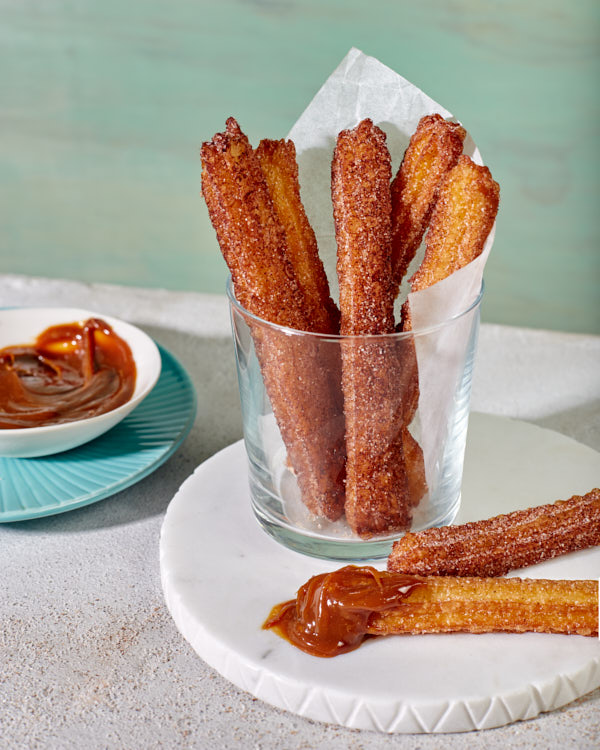
*To make Cajeta, a Mexican caramel sauce, replace the whole milk in the dulce de leche with goat’s milk and follow the same procedure.
*The whole milk can be replaced with half-and-half (10% cream) for a richer dulce de leche sauce.
*Serving options: chocolate ganache, strawberry sauce, vanilla glaze, or dipped in our “Mexican Hot Chocolate.”
*The churro dough can be made the day before. Store in the fridge in the pastry bag fitted with the star piping tip and placed into a resealable bag. Before using, bring the dough to room temperature (about 30 minutes) to make the dough easier to pipe.
*Batter can be placed into a smaller piping bag if it is difficult for you to squeeze a large amount of batter. Alternatively, place half of the batter into the prepared piping bag to make it easier to handle, filling the bag with the remaining batter after the first or second batch. Cover the remaining batter by laying a piece of plastic wrap onto the surface to prevent it from drying out.
*Use a closed star piping tip to get the distinct ridges characteristic of churros; in a pinch an open star tip will work. Do not use a piping tip with an opening larger than ½-inch; the churros will be too thick to cook completely through.
*Depending on how large the skillet or saucepan used for frying the churros, fry and/or pipe between 3 to 5 churros into the hot oil. Too many will bring the oil temperature down too low, increasing the cooking time and causing the churros to be greasy or soggy.
*Leftover fried churros (cooled completely) can be stored in an airtight container layered with parchment paper at room temperature for up to 2 days. They can also be placed into the freezer for up to a month. Reheat in a 350°F (177°C) oven for about 10 minutes to regain the crisp texture before serving.
*Piped churro batter (see Method 2) can be completely frozen (freeze for an hour) and then stored in an airtight container or a large freezer-safe bag, layered between parchment for up to 2 months. Fry from frozen; additional cooking time may be needed.
*Ensure oil comes back to the correct temperature before frying the next batch of churros.

